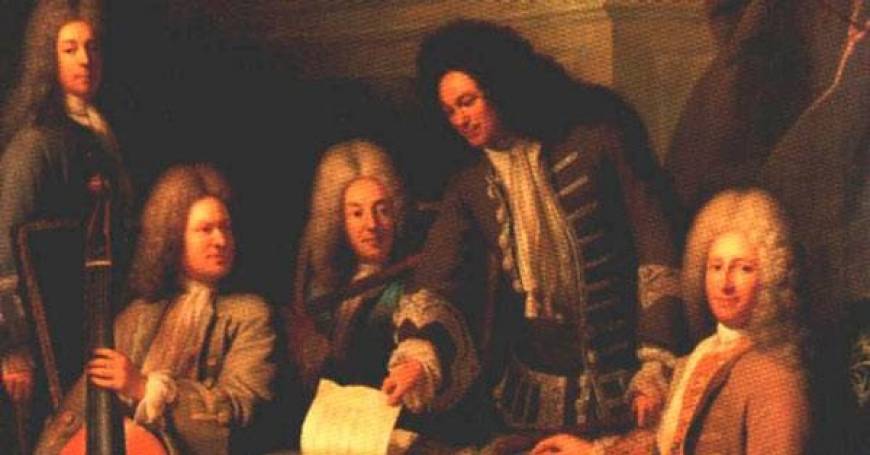The aesthetic I have chosen to explore is that of Baroque musical composition, a period of European musicianship lasting from 1600 to 1750. Well known within this period are composers such as Arcangelo Corelli (1653-1713), Tomaso Albinoni (1671-1751), Antonio Vivaldi (1678-1741), Georg Philipp Telemann (1681-1767), Johann Sebastian Bach (1685-1750), and George Frideric Handel (1685-1759) among others. Audio samples of these composers are included below with additional details to follow.
Arcangelo Corelli
Tomaso Albinoni
Antonio Vivaldi
Georg Philipp Telemann
Johann Sebastian Bach
George Frideric Handel
The word, baroque, is derived from the Portuguese word, barraco, meaning “oddly-shaped pearl.” While this phrase has little meaning today, in the 1600s and 1700s, it described baroque music in terms of its fierce ornamentation and exuberance. After all, Baroque music was written mostly as a luxurious form of royal entertainment. The most common musical forms emerging within the Baroque era were operas, oratorios, cantatas, sonatas, concertos, and suites performed only for high-class citizens.
Characteristics of this aesthetic are endless but I will start by naming just a few. First of all, Baroque music places great emphasis on contrast. Pay close attention to the difference between loud versus soft dynamics, string versus wind instruments, fast versus slow tempos, and solo versus ensemble passages. Secondly, Baroque music features a unique set of instruments. During this time, the use of violin and trumpet in musical composition grew immensely and instruments such as the viol, harpsichord, and lute became telltale signifiers of the era. Overall, more detailed and demanding specifications were made denoting which instruments were meant to play which parts. Lastly, the Baroque aesthetic is highly formulated, most always following patterns and utilizing multiple repeats. This makes for a less freely expressive sound, especially when compared to periods of musical composition such as that within the Romantic era by composers like Beethoven.
Most interesting to me, in terms of aesthetics, is the fact that Baroque composers wrote music with one overarching purpose: communication of a single emotion. Perhaps Plato’s suggestion that art is merely mimicry of truth can be reinforced by the way composers like Bach wrote pieces of music simply to convey a universal truth (an emotion) like happiness or sadness. Usually, it is not difficult to tell which emotion is being expressed.
As a violinist, I deeply enjoy the exploration of aesthetics in regards to music. Not only do I find myself listening to various pieces and guessing the eras to which they belong, but I also apply specific aesthetics to the music I, myself, then choose to play. For instance, when I play a piece by Bach, it sounds completely different than if I were to play the same notes and rhythms as a piece by Mozart. How incredible that the study of aesthetics has already become so personally applicable!


2 Comments. Leave new
It’s fascinating that we can listen to a piece of music and instantly get a similar emotional response. I haven’t seen a good consensus on why this happens, but I do remember hearing about a study that sheds some light on the phenomenon. In the study, they measure the emotional response to music in two different cultures: Canadians and Pygmies. Using Western music that the Pygmies had never heard and Congolese music that the Canadians had never heard, emotional and arousal (physiological) responses were measured. The results showed no correlation in the emotional responses, and good correlation in the arousal responses between the two groups. This suggest that while subjective emotional responses are mediated by cultural learning, arousal responses might involve a more basic, universal part of the senses/brain. I have heard that the emotional response to art is the feeling of empathy to the artist. Empathy generally requires some commonality in background/experience. If two groups of people have very little in common, it might make sense that they have different emotional responses to music.
Link to the study:
https://www.ncbi.nlm.nih.gov/pmc/articles/PMC4286616/
I forgot to leave strengths and suggestions…
Strengths:
I enjoyed the selection of samples you have embedded in the article. They elicit a good variety of emotions from the reader, which makes the message in the rest of the article much more powerful.
Suggestions for Improvement:
I’d like to see your take on the goal/purpose of using various forms of aesthetics by the Baroque composers. Can the aesthetics be deconstructed to convey certain emotions? How does the contrast or repetition affect the experience of the listener?